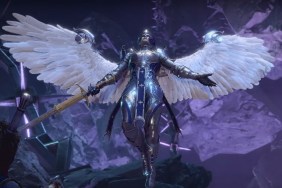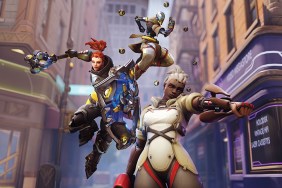This just in: Wizard Devours Sea-Monkeys!
For all the oft-touted powers of the PC, I say it still cannot hold a candle to
a good old stylus-and-parchment D&D gaming session. Sure, the computer eliminates unsightly wear and tear on your twelve-sided die, but this is hardly compensation for lack of general all-night hoo-hah.
Take the time my friend Angie (as Darcor the Wonder Wizard) got cotton-mouth
from some potent, ahem, “Elvish Herb” and mistook my jar of sea monkeys for
some tasty and refreshing ale. After drinking my experiment, I had her make
a saving throw versus – what else – Seaman!
Try simulating THAT on your computer.
Unfortunately, arranging late night D&D events is like trying to organize
D-Day. It’s much easier to take the path of least resistance and succumb to
computer gaming. While good PC RPGs are few and far between, Baldur’s
Gate set a new standard by which all other noteworthy RPGs must be measured.
When the sequel Baldur’s Gate II: Shadows of Amn hit the shelves, I,
like many other D&D and RPG geeks, could hardly wait to get it home and lose
myself in the world Faerun in the Forgotten Realms.
|
Click to enlarge!
|
The game takes place not long after Baldur’s Gate left off. You are
imprisoned with a handful of friends and are constantly being tested with magical
torture. Suddenly – suspiciously – you are allowed to break free, liberate your
comrades and wreak havoc throughout the dungeon as you scramble for the exit.
Hundreds of quests and subquests await you as you traverse the Sword Coast attempting
to unravel the riddle of your fate.
A hefty install across a massive four discs (slimmed down from the original’s
five), BGII:SofA has some pretty high end system requirements. Slow to
moderate-speed CPU’s may have trouble chewing on this and should expect slow
load times (but hope for the best).
Superficially, the game interface hasn’t changed much, but now the player can
configure the screen to suit their preference. You can now jettison command
and character bars and collapse the interface in a variety of ways. You can
even get a full-screen.
The graphics are lovely, a modest though all around improvement over the original. The dismal dungeons and lush forests are rendered in nice detail and give the environments an element of great size and depth. That’s all well and good. I love that part.
But I would also like to be able to see what my characters are doing. BGII:SofA
does an amazing job of creating an interesting world in which to play, but why
can’t we get a little love with the zoom? Once again, we are restricted to the
skycam for perspective. The pseudo 3D graphics make it possible to lose items
and characters behind structures, pieces of furniture, trees…anything bigger
than a toadstool. And because it is not truly a 3D environment, there’s no chance
of a rotate feature to allow you visual access to everything.
What the game lacks in perspective, it makes up for in character creation
options. You can import your character from Baldur’s Gate (sans possessions),
create a new one using the original careers or select from the new character
classes. You can now choose to play as a half-orc Priest of Lathander, for example,
or a gnome Wizard Slayer. There’s a fairly large variety of intriguing character
classes to choose from. Because NPCs will react to you largely based on who
and what you are, this adds a great deal to the replay value.
 |
|
Click to enlarge!
|
Like the original, alignment is a big issue. You can choose each character’s
alignment from the get-go, which remains fixed throughout the game (like in
original D&D…and unlike last year’s RPG of choice, Planescape
Torment). You’re sort of herded into playing characters of good reputation
or you’ll suffer high prices and social indignities, the stigma of evil-doers
everywhere within the lands of Faerun. I don’t have a problem with the concept
of reputation, but how can you get a bad rep from doing evil deeds if there
are no witnesses? Evil-doers shouldn’t get bad reputations unless they’re doing
evil badly.
Spells abound in BGII:SofA and their explanation takes up half of the
260+ page instruction booklet…er…tome (an index would have been a worthy
addition to a book of this size). Spells are more plentiful in this one than
they were in the original, and a bit more interesting. Mages happening upon
the right spell, for instance, can summon a familiar, a companion with a few
helpful abilities, not least of which is boosting the mage’s total hit points.
Maximum Experience Points within the game have been increased to nearly 3 million.
This allows for the creation of extremely powerful characters (upwards of Level
20 for some classes). They have also included higher level and more interesting
D&D creatures, like Liches, Rakshasas and Dragons. This adherence to D&D resources
is what pulls Baldur’s Gate, Icewind Dale,
and Baldur’s Gate II: Shadows of Amn head and shoulders above other so-called
“RPGs” which are based on nothing and play like 8-bit adventure games with plots
straight out of ElfQuest. The lads and lasses over at developers Bioware
and Black Isle should get big fat raises.
Baldur’s Gate II: Shadows of Amn is one of the best RPGs available for
the PC. It is stuffed with adventure, gold, guts, and glory like an RPG should
be. It is the kind of game you could easily find yourself dusting off two years
from now and enjoying just as thoroughly. If this had come out a few years earlier,
I could have spared a happy little family of sea monkeys a ghastly fate.
 |
|
Click to enlarge!
|
-
Great graphics
-
More interesting character classes
-
Very immersive world
-
Options galore
-
Still no rotating camera
-
Not good to be evil







